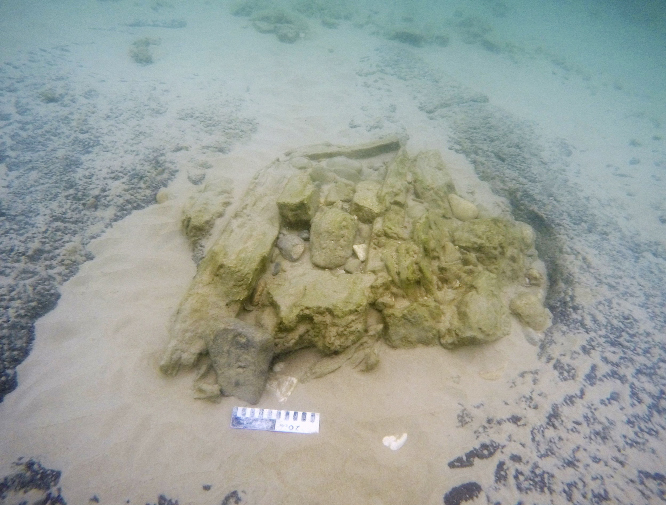
AP, Israel :
An international team of researchers says it has discovered a 7,000-year-old-seawall along Israel’s Mediterranean coast, providing evidence that coastal communities protected themselves against rising waters even in ancient times.
The scientists believe the more than 100-meter-long (110-yard-long) structure acted as a fortification against surging waters and storms. The study, published Wednesday in the Public Library of Science One journal, said the Neolithic era village, called Tel Hreiz, was abandoned and eventually swallowed by the sea.
“Here we have an example, a practical example of a process that is still going on. We can see a whole community which are now under the sea,” said Ehud Galili, lead researcher and archaeologist from Israel’s Haifa University.
The researchers believe the structure was built by villagers out of riverbed boulders found several kilometers (miles) away. The site lies just south of the northern Israeli port city of Haifa.
While seas were rising at a faster rate during the Neolithic period than they are today, the causes were much different, according to co-author Jonathan Benjamin from Flinders University in Australia.
“There’s a big difference between climate change and prehistory which was naturally occurring, and climate change now, which is due to this huge human intervention,” Benjamin said.
Still, similar to contemporary coastal communities, Benjamin said the villagers of Tel Hreiz had to make “the very human decision” to stay or go as the coastline receded.
The ancient settlement was first exposed in the mid 1960s and re-covered by thick sands. After winter storms along the coast in 2012 and 2015 moved these sediments, the structure was uncovered.
Archaeologists have also dug up pottery, animal and human remains that, based on carbon dating, are believed to be from the same settlement.
The community, Galili said, was an “early Mediterranean fishing village” which relied on farming, animal husbandry and exploitation of the land and sea. During the excavations, they also found early examples of olive oil extraction.
An international team of researchers says it has discovered a 7,000-year-old-seawall along Israel’s Mediterranean coast, providing evidence that coastal communities protected themselves against rising waters even in ancient times.
The scientists believe the more than 100-meter-long (110-yard-long) structure acted as a fortification against surging waters and storms. The study, published Wednesday in the Public Library of Science One journal, said the Neolithic era village, called Tel Hreiz, was abandoned and eventually swallowed by the sea.
“Here we have an example, a practical example of a process that is still going on. We can see a whole community which are now under the sea,” said Ehud Galili, lead researcher and archaeologist from Israel’s Haifa University.
The researchers believe the structure was built by villagers out of riverbed boulders found several kilometers (miles) away. The site lies just south of the northern Israeli port city of Haifa.
While seas were rising at a faster rate during the Neolithic period than they are today, the causes were much different, according to co-author Jonathan Benjamin from Flinders University in Australia.
“There’s a big difference between climate change and prehistory which was naturally occurring, and climate change now, which is due to this huge human intervention,” Benjamin said.
Still, similar to contemporary coastal communities, Benjamin said the villagers of Tel Hreiz had to make “the very human decision” to stay or go as the coastline receded.
The ancient settlement was first exposed in the mid 1960s and re-covered by thick sands. After winter storms along the coast in 2012 and 2015 moved these sediments, the structure was uncovered.
Archaeologists have also dug up pottery, animal and human remains that, based on carbon dating, are believed to be from the same settlement.
The community, Galili said, was an “early Mediterranean fishing village” which relied on farming, animal husbandry and exploitation of the land and sea. During the excavations, they also found early examples of olive oil extraction.

